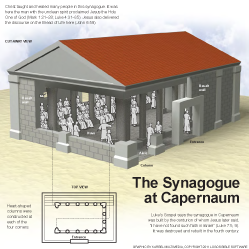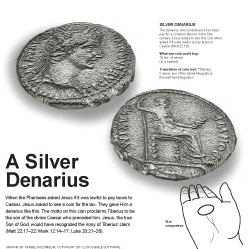7:1–10 The report of Jesus healing the centurion’s slave demonstrates that not just Jews, but also Gentiles (non-Jews), can have faith that is acceptable to Jesus (compare Matt 8:5–13). By including narratives like this one, Luke continues to support his central theme that Jesus is the Messiah for the whole world (see Luke 2:10 and note). |
7:1 Capernaum See note on 4:31. This fishing village on the northern shore of the Sea of Galilee served as Jesus’ base of operations during His public ministry.
7:2 centurion’s A centurion was a Roman military officer in charge of roughly 80 soldiers.
7:3 he sent Jewish elders Since he was a Gentile (non-Jew), the centurion sent Jewish leaders to vouch for him to Jesus, a Jewish teacher.
7:4 He is worthy The elders’ opinion of the centurion is based on his generosity to the Jewish community. The centurion himself recognizes that he is not worthy (vv. 6–7).
7:6 I am not worthy Coming from a leader in the Roman occupying force, this would have been a shocking expression of reverence toward a Jewish teacher.
7:8 a man placed under authority The centurion recognizes that Jesus has considerable authority over sickness, similar to his own authority within the military chain of command.
7:9 such great faith This statement, praising one of Israel’s foreign rulers, would not have been well received by Jesus’ Jewish listeners. Jesus frequently links faith and healing (compare Luke 5:20).
7:11–17 This is the first incident of Jesus raising someone from the dead in Luke’s Gospel. The episode portrays Jesus like Israel’s great prophets, as He restores life to a woman’s son—a miracle also performed by Elijah and Elisha. |
 Miracles of Jesus Table
Miracles of Jesus Table
7:11 Nain Approximately 20 miles southwest of Capernaum.
7:12 was being carried out Graveyards were typically located outside the city walls for the sake of ritual cleanliness (see Num 5:1–4; 19:11–20).
she was a widow With no husband or sons, the widow’s means of provision were gone. She would be forced to rely on the charity of her neighbors and struggle for her livelihood.
7:13 he had compassion Jesus is moved to action due to her suffering and destitution.
7:16 A great prophet has appeared among us Accounts of Elijah and Elisha raising sons from the dead appear in 1 Kgs 17:17–24; 2 Kgs 4:32–37. The parallel between Jesus and Elijah is a prominent theme in Matthew (see Matt 16:14 and note).
 Jesus and His Witnesses as Prophets in Luke—Acts
Jesus and His Witnesses as Prophets in Luke—Acts
7:18–35 In this section, John the Baptist sends his disciples to question Jesus about His messianic identity (compare Matt 11:1–19). Jesus takes the opportunity to praise John to His listeners, rebuking those who failed to heed John’s message. |
7:18 all these things Refers to the events in Luke 7:11–17 and probably Jesus’ other reported teachings and healings (e.g., those recorded in chs. 4–6).
7:19 Are you the one who is to come A legitimate question, since John is in prison at this time.
7:22 tell John what you have seen and heard Rather than answering John’s question directly, Jesus points to His works that fulfill Isaiah’s prophecies related to the Messiah (e.g., Isa 26:19; 29:18; 35:5–6; 42:18; 61:1). This is a further example of Luke portraying Jesus as the Messiah figure in Isaiah (see Luke 1:27 and note).
7:23 is not offended by me Jesus is aware that His message is difficult for some to accept; this is partly because Jesus did not fulfill the messianic expectations of His day—people were hoping for a ruler who would overthrow Rome (see Matt 11:6 and note).
7:26 more than a prophet John was not only a prophet; he was the forerunner to the Messiah. See Matt 11:9 and note.
7:27 sending my messenger before your face A quotation of the prophecy of Mal 3:1 (see Matt 3:3 and note).
7:28 no one greater Jesus emphasizes the superiority of God’s kingdom, contrasting heavenly greatness with earthly greatness. John was great because he had prepared for the Messiah; now the Messiah and His kingdom are here, offering a far greater ministry of righteousness. Compare Matt 11:11.
7:30 Pharisees and the legal experts See note on Luke 5:17.
rejected the purpose of God for themselves Refers to a rejection of God’s plan for salvation. John’s baptism had announced a new era in God’s redemptive work—the coming of the Messiah and the inauguration of the kingdom of God.
7:32 We played the flute for you Jesus may be quoting some common children’s song of the time. Jesus’ imagery here describes the refusal to participate in God’s unfolding kingdom, which involves both celebration and judgment. Compare Matt 11:17 and note.
7:33 not eating bread Possibly refers to fasting (see Luke 5:33).
or drinking wine This might refer to John’s Nazirite vow (see Num 6:1–4).
7:34 eating and drinking Jesus did not fast like the disciples of John (see Luke 5:33), and He was not under a Nazirite vow like John was. Furthermore, He was known for dining with tax collectors and sinners—those whom He clearly says He came to save (see 5:27–32). The Jewish religious leaders rejected the ministries of both John and Jesus.
7:35 wisdom is vindicated by all her children This likely reflects a proverbial saying in Jesus’ day—essentially meaning that a teaching is shown to be wise based on what it produces (compare 6:44).
7:36–50 Luke reports a woman anointing Jesus’ feet and pairs this scene with a parable about forgiveness. Matthew places this event just before the last supper and portrays it as related to Judas’ betrayal (Matt 26:6–13; compare Mark 14:3–9). |
7:36 one of the Pharisees Although Jesus often rebuked the self-righteousness of Israel’s religious leaders, they were not always antagonistic toward one another.
7:37 an alabaster flask of perfumed oil A costly item. Mark and John both record its cost as 300 denarii (roughly a year’s wages for a laborer; Mark 14:5; John 12:3).
7:39 what kind of woman The Pharisee’s comment here might indicate that the woman was a prostitute.
7:40 Simon In Matthew’s account, this refers to Simon the Leper, a Pharisee who might have been cured of leprosy by Jesus (see Matt 26:6 and note).
7:41 denarii The denarius was the usual daily wage for a laborer. A debt of 500 denarii was seemingly insurmountable.
7:42 which of them will love him more Rather than making the point Himself, Jesus prompts Simon to give an answer that condemns his own attitude. Jesus uses this same tactic with the parable of the good Samaritan (Luke 10:36–37).
7:43 to whom he forgave more The parable reflects the scene. The woman, who appeared to be in great need of forgiveness, expresses her love and appreciation more than the Pharisee, who likely thought that he needed little or no forgiveness (compare v. 47).
7:46 You did not anoint my head Jesus contrasts the woman’s devotion and care with Simon’s failure to do anything to honor his invited guest.
7:49 Who is this who even forgives sins Forgiveness of sins could be granted by God alone. See 5:21 and note.
7:50 Your faith has saved you Jesus often recognizes faith as the catalyst for healing and salvation (see note on 5:20).

|
About Faithlife Study BibleFaithlife Study Bible (FSB) is your guide to the ancient world of the Old and New Testaments, with study notes and articles that draw from a wide range of academic research. FSB helps you learn how to think about interpretation methods and issues so that you can gain a deeper understanding of the text. |
| Copyright |
Copyright 2012 Logos Bible Software. |
| Support Info | fsb |
 Loading…
Loading…


